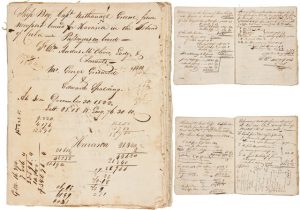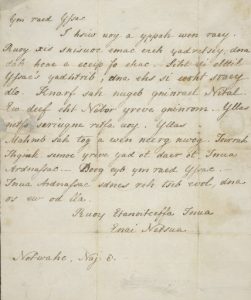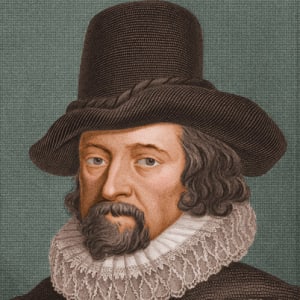How does the usage of the most frequently used words change throughout the memoir? Elizabeth Grundy writes a memoir of her life that she dedicates to her son, Br. James Grundy. Elizabeth lost her husband and became a widow, never remarrying before her death. Grundy was a very religious woman and relied heavily on God. Her father passed when she was young leaving her mother to care for the children. Grundy’s husband passed when he was 29 leaving her with a home, a baby, and a soon-to-be newborn. Immediately, Elizabeth had her newborn son join the church, so he would have a “father”, God. Elizabeth and her son, William, kept religion a top priority throughout their lives. Eventually, Elizabeth fell ill with her son, William, at her side. He told her it was time to go, and she passed peacefully at the age of 82.
After inputting the text into Voyant, it was determined that there are 4,888 words with 1,222 unique word forms. Her memoir has a vocabulary density of 0.25, ¼ of her word choices are unique. She also averages 28.1 words per sentence which seems to be high for a typical paper. Voyant provides researchers with the five most frequently used words in the corpus. After analyzing Elizabeth Grundy’s memoir, I am not surprised to see that the five most frequently used words are: Savior, time, son, God, and Jesus. The majority of the memoir is written about her life with her son and the way in which they incorporate religion into their lives. There are Grundy’s two most important things in her life, religion and her beloved son. Time can also relate to the time Elizabeth has left on Earth and the time until she reaches her final destination, heaven.
After analyzing the four sections we broke Grundy’s memoir up into, it has been determined that she speaks heavily of her son and the Savior throughout the entire writing. The keywords listed are: God, Brethren, life, Jesus, and Savior. God mainly has the collocate, people, and a few times has Savior. Brethren’s collocate is church while life’s is departed. This exemplifies Elizabeth Grundy speaking of passing over. Jesus’ collocates range greatly from the word mercy to the word end. The same types of words are used throughout the text. Everything seems to fall back on her son or religion.
Whitley talks about distant reading, the use of digital technology to recognize patterns. This type of reading can be used for one text or to compare multiple texts. We see this use of digital technology with the tools provided in Voyant. Whitley also speaks of the importance of using patterns during writing. He believes the brain is able to comprehend information quicker when using patterns. To determine how the usage of key terms changes throughout the passage, I have used the StreamGraph tool provided by Voyant. This tool graphs the 5 most frequently used words with each word having its own horizontal line on the graph. The lines are color-coded and they fluctuate throughout the graph representing the increase and decrease in usage. The more the words are used in a specific section, the higher the hump on the line goes. For example, Jesus has a very high bump towards the end of the first third of the passage but does not have a visible bump in the beginning. This shows that the word, Jesus, is used heavily at the end of the first third of the passage unlike at the beginning where it is not really used. At the end of the passage, the graph shows the words, Jesus and son, being used heavily. This makes sense because Grundy was dying at the end of the memoir and wrote frequently of how her son would be after her passing as well as praying to Jesus. Savior is used frequently during the memoir whereas God is only used in certain sections of the reading.
Trends is another tool that graphs the relative frequencies of the key terms verse the document segments. This tool is similar to the StreamGraph as it creates hills and valleys as the usage increases and decreases throughout the different sections of the memoir. Trends places a dot at the specific frequency for each word at each segment. The dots are then connected creating these lines. By hovering over each dot, researchers are able to determine the exact frequency of that word in that section.
The last tool I used to analyze patterns in the passage is the WordTree tool. WordTree places one of the key terms at the center of a “tree” and surrounds it with different useful words that are in front and behind the keyword throughout the memoir. These words that make up the “branches” of the “tree” are called collocates. For example, the collocates of the word Savior are dear, our, and my. Researchers also have the ability to click on these collocates, and the collocates of that specific collocate will appear as smaller “branches” connecting to the collocate. This allows researchers to analyze the different contexts the keywords are used in throughout the passage. These tools provided by Voyant are examples of spatial reading as talked about in the Whitley reading. Spatial reading involves the digital visualizations used to further the comprehension of the passage. It accesses different parts of the brain to do this.
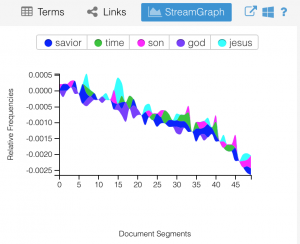 https://voyant-tools.org/?corpus=9bf1521b2f9d4815fd5232b94d287908
https://voyant-tools.org/?corpus=9bf1521b2f9d4815fd5232b94d287908
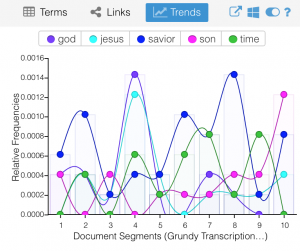 https://voyant-tools.org/?corpus=9bf1521b2f9d4815fd5232b94d287908
https://voyant-tools.org/?corpus=9bf1521b2f9d4815fd5232b94d287908
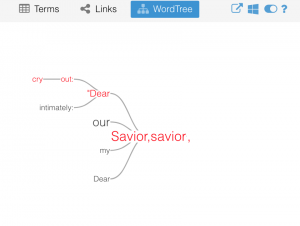 https://voyant-tools.org/?corpus=9bf1521b2f9d4815fd5232b94d287908
https://voyant-tools.org/?corpus=9bf1521b2f9d4815fd5232b94d287908
Megan Koczur is a sophomore student at Bucknell University. She is a member of the Bucknell Swim and Dive team and intends on majoring in Computer Science and Engineering. She resides in West Chester, Pennsylvania with her her father, mother, sister, Erin, and two black labs, Brandy and Max.
